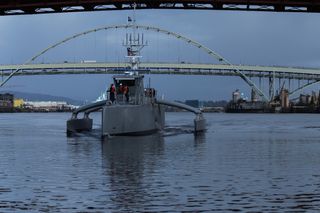
A new hunter is lurking in the deep — and it's made of metal, silicon, and lots and lots of artificial intelligence.
The Defense Advanced Research Projects Agency (DARPA) officially launched its unmanned submarine-hunting ship, holding a christening ceremony on Thursday (April 7) for the "Sea Hunter." The new vessel is part of DARPA's larger initiative to use artificial intelligence (AI) for a wider array of military decisions and tasks. The seafaring drone's task is to find and neutralize enemies' ultraquiet diesel submarines, the agency said.
While the Sea Hunter, which is part of DARPA's Anti-Submarine Warfare Continuous Trail Unmanned Vessel (ACTUV) program, is not helmed by a human captain, people are still in the loop (at least for now). [Humanoid Robots to Flying Cars: 10 Coolest DARPA Projects]
"Although ACTUV will sail unmanned, its story is entirely about people," Scott Littlefield, DARPA program manager, said in a statement. "It will still be sailors who are deciding how, when and where to use this new capability and the technology that has made it possible."
Autonomous sub-hunter
The Sea Hunter is a 130-foot-long (40 meters) vessel that is part futuristic AI, part eerie ghost ship: Thanks to its advanced software, the drone ship will be able to cross thousands of miles of ocean for months with no one aboard.
Because the Sea Hunter is unmanned, the designers of the ship made some novel choices. While sub hunting ships aren't known for being roomy in the first place, this one's interior spaces are even more cramped, just big enough for maintenance crews to do their work, but not equipped or large enough to support crew living onboard long-term.
Sign up for the Live Science daily newsletter now
Get the world’s most fascinating discoveries delivered straight to your inbox.
The artificial intelligence running the Sea Hunter will work continuously to navigate safely around other ships, in rough waters, and in both daytime and nighttime conditions, DARPA said. In fact, a surrogate ship showed it was capable of adhering to all maritime safety laws and regulations, the agency added.
While the ACTUV ships are designed to run on their own, they can also be remotely guided for particular missions. Using these human-free subs would be much cheaper than manning an equivalent ship, DARPA said in a statement.
The new ship's maiden voyage is really an extended test of the vessel's prowess. But if the "Sea Hunter" passes that trial, other versions could be seafaring by 2018, when the U.S. Navy plans to roll them out as part of its fleet.
This isn't the only military technology brewing that puts AI in the captain's chair, driver's seat or cockpit. DARPA also has plans to make robot battlefield-managers that can help decide the next move in a space war, as well as AI that can automatically decode enemy messages during air reconnaissance missions.
Follow Tia Ghose on Twitterand Google+. Follow Live Science @livescience, Facebook & Google+. Original article on Live Science.

Tia is the managing editor and was previously a senior writer for Live Science. Her work has appeared in Scientific American, Wired.com and other outlets. She holds a master's degree in bioengineering from the University of Washington, a graduate certificate in science writing from UC Santa Cruz and a bachelor's degree in mechanical engineering from the University of Texas at Austin. Tia was part of a team at the Milwaukee Journal Sentinel that published the Empty Cradles series on preterm births, which won multiple awards, including the 2012 Casey Medal for Meritorious Journalism.
